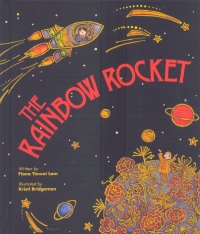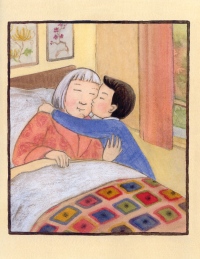| ________________
CM . . .
. Volume XX Number 9. . . .November 1, 2013
excerpt:
The Rainbow Rocket follows James's relationship with his grandmother and traces a child's encounter with Alzheimer's, his experience of the death of a grandparent, and the commemoration of his grandmother through the art that they shared together when she was alive.
Time shifts onward a few months into a different season, and James notices his grandmother's tiredness and short attention span as she can no longer muster energy to paint with him. A few months later, James visits his Poh-Poh at the nursing home where she no longer talks, or she says things that make no sense, her thoughts and words 'jig-saw pieces' that don't fit together any more. These episodic glimpses into James's interactions with his grandmother detail the marked changes that Alzheimer's disease has wrought in her life. James' emotions, subdued, confused, and saddened by the change in his grandmother, are never over-dramatized or sentimentalized by Lam. James visits his Poh-Poh in the hospital as she has days left to live, and he deals with his sorrow by drawing picture after picture, leaving behind his rainbow rocket, based upon the first rocket she helped him draw, in the hopes that it will be the first thing his grandmother sees when she wakes up. A particularly poignant interlude in the story takes place when, on the night of his grandmother's passing, James dreams of travelling on his rainbow rocket to the moon where his grandmother is alive and well again. The sequence is illustrated with the figures and objects outlined in glowing gold. Poh-Poh creates art from a paintbrush that brings to life everything it makes, from a horse to a bowl of peaches. James is delighted to find that his grandmother has 'found her words again', and he falls asleep in the dream in her arms. The story ends with the renewal of spring, during April, as James and his family, along with many other families, honour their dead during Ching-Ming. Instead of burning the customary imitation paper money, James burns a picture of the rainbow rocket he saw in his dreams; he and his mother watch the smoke from the picture lift to the sky. I appreciate how James is never told how he should be responding to his grandmother's decline and passing--instead, Lam gives him room to come up with a meaningful tribute to his beloved grandparent, and he experiences a catharsis of sorts in honouring his grandmother in his own special way. His experiences are deeply personal as the bond of love and art with his beloved grandparent also links him to specific cultural practices, and yet this story is also universal and relatable for every child. The Rainbow Rocket is a picture storybook best shared with older children as it is text-heavy. It invites discussion of similar stories of children and their experiences with death in the family as well as the different cultural practices associated with mourning and honouring the dead. A glossary of terms expands upon the cultural nuances of the story more fully rather than bogging down the narrative with explanations. Bridgemanís illustrations, with their bright colours and softened edges, perfectly match the gentle lyricism of the text. The Rainbow Rocket is a touching, understated story, and deserves a place on the school and public libraryís shelf for its sensitive portrayal of one young boyís experience with a grandparentís death which has a message for any child who reads it. Highly Recommended. Ellen Wu is the teen services librarian at Surrey Libraries in BC.
To comment
on this title or this review, send mail to cm@umanitoba.ca.
Copyright © the Manitoba Library Association. Reproduction for personal
use is permitted only if this copyright notice is maintained. Any
other reproduction is prohibited without permission.
NEXT REVIEW |
TABLE OF CONTENTS FOR THIS ISSUE
- November 1, 2013.
AUTHORS |
TITLES |
MEDIA REVIEWS |
PROFILES |
BACK ISSUES |
SEARCH |
CMARCHIVE |
HOME |

 Told in the present tense, the story opens with James and his grandmother in her richly hued home where James not only observes his grandmother at her work, but he also joins in as an apprentice artist. James learns how to draw a rocket, an act which prompts him to follow in his grandmotherís footsteps to become an artist, himself. James also receives a name chop from his grandmother, a stamp that bears his Chinese name, carved on top with the figure of a horse, the same animal sign on the Chinese zodiac that they both share.
Told in the present tense, the story opens with James and his grandmother in her richly hued home where James not only observes his grandmother at her work, but he also joins in as an apprentice artist. James learns how to draw a rocket, an act which prompts him to follow in his grandmotherís footsteps to become an artist, himself. James also receives a name chop from his grandmother, a stamp that bears his Chinese name, carved on top with the figure of a horse, the same animal sign on the Chinese zodiac that they both share.